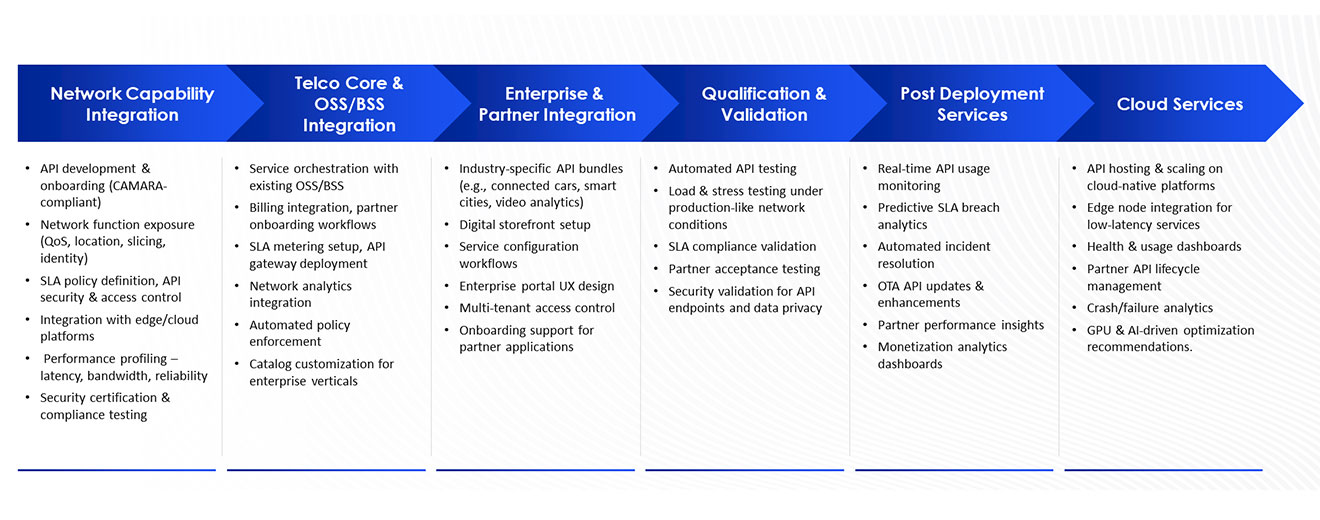

Tata Elxsi and GSMA Announce Joint Focus to Accelerate Operator Network Monetization and Enterprise API Adoption
Tata Elxsi and GSMA join forces to Accelerate Telecom Network Monetization and Enterprise API Adoption
Read more

Tata Elxsi and Evergent Launch Unified Digital Storefront for Media and Telecom Operators
Introducing Subscription Hub, a ready-to-deploy digital storefront and marketplace that delivers intelligent bundling, and seamless multi-service monetization.
Read more

Tata Elxsi and Red Hat Partner to Boost 5G Network Monetization
A strategic collaboration to help telcos unlock 5G value with industry-specific use cases, real-time services, and reduced operational costs.
Read more

Driving Revenue with CAMARA API: Subscription Model for SDVs
New Revenue Streams for Telco & Automakers through Connected Vehicle Platform Powered by CAMARA API and Subscription Framework
WhitepaperDriving Growth Through Intelligent Network Monetization
As telecom operators evolve into digital service providers, the industry is witnessing a paradigm shift from selling bandwidth to delivering experience-driven, on-demand network services. The emergence of 5G, edge computing, and cloud-native architecture has opened unprecedented opportunities to create new B2B2X models, enterprise marketplaces, and API-driven service ecosystems. Telcos now face a pivotal opportunity to unlock new revenue streams and deliver differentiated digital experiences.
Tata Elxsi empowers service providers to move beyond connectivity transforming networks into dynamic platforms for innovation and growth. It enables operators to capitalize on this transformation by monetizing network capabilities and turning connectivity into scalable revenue opportunities. Through AI-driven assurance, Network APIs and GPUaaS, we empower telcos to launch differentiated, SLA-backed services faster driving innovation, operational agility, and ecosystem growth.
Business Challenge
With evolving digital ecosystems and evolving service expectations, operators are exploring ways to unlock more value from their network assets, requiring smarter frameworks to convert network capabilities into differentiated, revenue-generating offerings.


Here’s how we help
Unlock New Revenue Streams and Service Models
- Enable telcos to monetize 5G, Edge, Cloud, Carrier-grade NaaS and cloud investments by offering on-demand services for industries like connected cars, smart cities, video analytics, and industrial IoT
- Low-code portals, API exposure via CAMARA, and flexible pricing engines allow rapid creation and launch of new service offerings within a few months
- Partner onboarding accelerated by up to 60%, enabling faster ecosystem growth and new B2B opportunities
Deliver SLA-Backed, Industry-Specific Experiences
- AI-driven SLA enforcement and real-time API metering ensure 95% compliance for mission-critical applications and improved time-to-cash by 30%, boosting B2B ARPU by 20–25%
- Digital storefronts and vertical-specific service catalogs empower enterprises to select, customize, and activate network capabilities instantly
- Support QoS differentiation across RAN, transport, and core networks for performance-sensitive applications
Boost Operational Agility and Reduce Costs
- Integrated OSS/BSS extensions and orchestration layers streamline service rollout, reducing go-to-market timelines by 3x
- Reusable service templates and pre-tested CAMARA APIs minimize engineering effort, lowering operational costs
- Flexible deployment models adapt to telco business strategies from private network monetization to nationwide API marketplace
Service Framework

Use Cases
Network Exposure & API Monetization
- CAMARA APIs (QoS / slicing / identity / location)
- Secure onboarding & policy control
- Edge/cloud integration for low latency
- Performance profiling (latency, reliability, compliance)
OSS & Partner Ecosystem Integration
- OSS orchestration & billing
- Vertical API bundles (automotive, smart city, video)
- Digital storefront & partner onboarding
- SLA metering & automated enforcement
Validation, Operations & AI Optimization
- Automated API & stress testing
- Real-time usage & SLA analytics
- OTA API updates & incident automation
- AI/GPU-based optimization & monetization dashboards
Why Tata Elxsi?
- Trusted Partnerships: Collaboration with Industry leaders + Tata Elxsi platforms (NEURON NaaS) for end-to-end delivery
- Flexibility and Agility: Low-code, cloud-native and modular - tailored for industry specific needs
- Ecosystem Support: TM Forum APIs, CAMARA, hyperscalers (Azure/AWS/Google)
- Proven Impact: 3× faster partner onboarding, 25% boost in ARPU from monetized services
- Ready-tested Components: API marketplace, GPUaaS wrapper, private 5G packaging
- Plug-and-Play Modules: Pre-built portals and API gateways for faster time to market and cost optimization by reusing existing OSS/BSS infrastructure
Information Hub
-
How does the AI Telco Fabric quantify and expose network capabilities for external consumption?
Network capabilities are exposed as API-defined service objects with associated performance attributes and policy metadata. These include parameters such as bandwidth, latency, and topology context, enabling programmatic discovery, dynamic provisioning, and intent-based consumption by external systems.
-
How is service quality maintained through continuous assurance?
Continuous assurance is achieved through real-time comparison of operational metrics against predefined service-level objectives (SLOs). When deviations are detected, policy-based orchestration triggers automated corrective actions, maintaining service integrity and compliance.
-
How is AI applied to capacity planning and utilization analysis?
AI models perform predictive forecasting based on historical usage patterns and real-time telemetry. These models identify underutilized or overloaded assets, enabling dynamic resource allocation, scaling decisions, and energy efficiency optimization across the infrastructure.
-
How does the architecture support multi-tenant isolation in Network-as-a-Service models?
Multi-tenancy is enforced through logical segmentation within the control plane using policy contexts. Each tenant operates within an isolated resource domain, which is independently orchestrated, monitored, and assured, ensuring non-interference and compliance with isolation guarantees.
-
How are operational metrics linked to business and performance objectives?
Legacy systems are abstracted using a semantic data model that normalizes configurations and operational states. This abstraction layer enables uniform API-based management, allowing orchestration tools to interact consistently across legacy and cloud-native environments.







